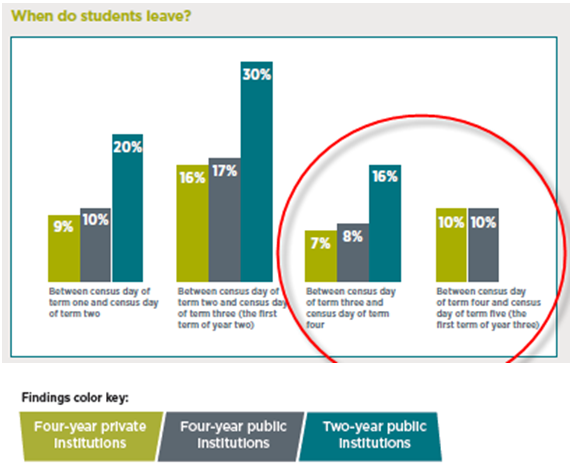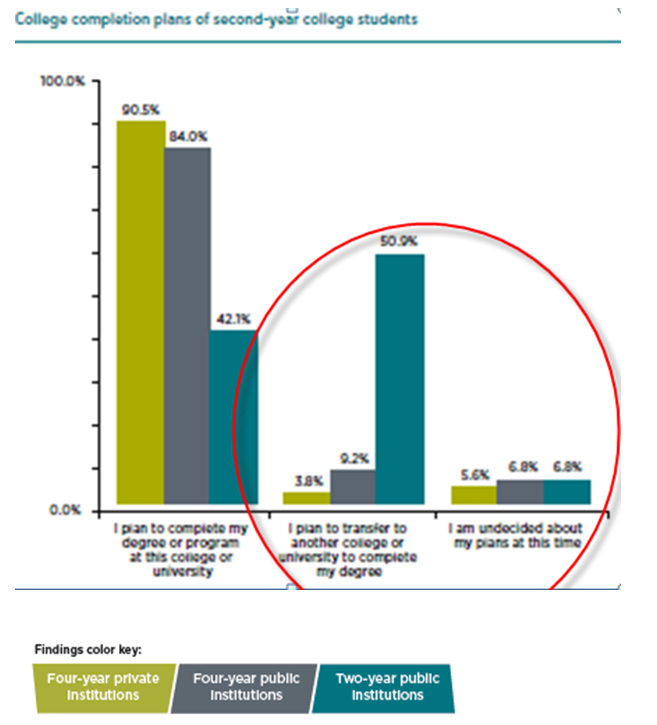enrollment
Why create a 1st through 4th semester plan for college student success and retention?
One of the assumptions operating in higher education is that once college students make it to their second year of enrollment, they are committed to completing their degrees at their current institution. And, yet, the data from the 2015 Student Retention Indicators Report show there continues to be significant attrition after the first year of enrollment:

Now new data from a second report, Attitudes of Second-Year College Students, confirm the problem, showing approximately 16 percent of second-year students at four-year public institutions and 9 percent of second-year students at four-year private institutions are either uncertain about their plans or are planning to transfer as they begin their second year:
College completion plans of second-year college students

But very few institutions have made the commitment to retention programs designed specifically for second-year students:

Institutions will not realize improved graduation rates unless they make changes in how they are attending to the needs of second-year students in addition to what they have been doing for their first-year students. This calls for the creation of a “1st through 4th semester” strategy for student success.
5 recommendations for building an effective 1st to 4th semester plan
How should a four-year institution or a two-year institution get started with expanding student success efforts beyond the first year? Data from the aforementioned report on the attitudes of second-year college students offer some guidelines. Here are five recommendations for shaping the programs and resources that will improve the retention rates of second-year students, based on student responses to our noncognitive survey, the Second-Year Student Assessment.
- Address the advising and career development needs of second-year students early in the second year. Almost 80 percent of the second-year college students surveyed reported they wanted help identifying work experiences or internships related to their majors as they began their second year. In addition, more than two-thirds asked for support in defining goals related to their majors and careers, along with the opportunity to discuss the advantages and disadvantages of their current career choices. And while almost 78 percent reported they planned to continue with the major they had selected, that left a significant number of students who were still searching for the right major “fit.”
- Provide academic support to second-year students. Students’ survey responses also indicated significant needs for assistance in getting tutoring and help with study skills as their classes were getting under way. Fully 73.3 percent reported they planned to study harder than they did in year one. Ensuring that academic support services expand to address the needs of second-year students is obviously necessary.
- Address the financial concerns of second-year students. Only 55 percent of the second-year students surveyed reported they had the financial resources needed to finish college. An equal percentage of the second-year students requested opportunities to discuss financing their education and help with managing their personal finances. Recommendation: Target financial literacy programs to second-year students.
- Continue to create opportunities for second-year students to deepen their “sense of belonging” at the institution. About 30 percent of second-year students reported that they did not have many friends or feel at home at their institutions.
- Develop a more holistic view of second-year students. Gathering noncognitive data that goes beyond GPAs and credits earned (although these are important markers, too) will expose issues that impede student success and expectations students have about their second-year experience. Try to answer the question: What is the unique pathway forward for each cohort, each subpopulation, and each individual student in order to achieve institutional goals?
The first place to start is with the data—gathering the right data and making use of it to inform planning and drive decisions about aligning resources with the needs of second-year students. If you are interested in collecting noncognitive survey data with the Second-Year Student Assessment, please email me.
To receive all of our new reports, sign up at the Ruffalo Noel Levitz website.